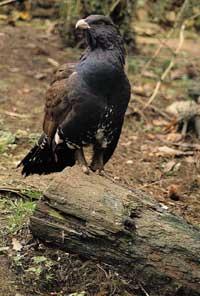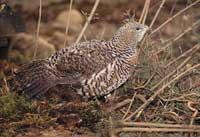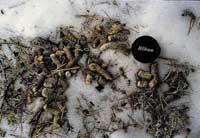Giant Montane Forest Rooster

The wild is actually a paleoarchaic bird, with its residence in the extensive taigas of northern Eurasia. In central and southern Europe, birds have had to take refuge in mountainous areas, both because of the temperate climate and the need to flee the relentless pressure of man.
Therefore, in the Iberian peninsula the Basoilarra is located in the Cantabrian Mountains and the Pyrenees, in this last mountain range especially in the northern slope and in some forests of Aragoa and Catalonia. As for the Basque Country, on the borders of Navarre and Zuberoa you can find it in Larrea and its surroundings, sheltered from the beech, abetal and mountain pine forests of the area (and here there is also a relatively small population; Purroy said that in 1974 there lived about six specimens, J. Elosegi, meanwhile, in 1985 deforms a population of between 10 and 20 birds.

The rooster is a gigantic rooster that inhabits the mountain forests, and as far as its biology is concerned, its remarkable sexual dimorphism is a reflection of the great difference between the ways of life of males and females. Wild birds are large and spectacular, with an approximate length of 85 cm and a weight ranging between 3,500 g.
As for their appearance, they are birds adorned with dark but striking clothing: while the color on the wing is dark brown, the feathers on the bottom present a raw black with bluish green glitter, with predominance of dark gray on the chest and on the tail. The whitish beak and the red eyebrow voragine are the characteristics that make up the shameless and arrogant appearance of the animal.
As for the female, it shows slightly lower sizes and garments. The female rooster does not exceed 62 cm in length and its weight ranges between 1,500 and 2,300 g, half the rare. As for the plumage, it also has a reddish brown painted and cryptic coloration, not suitable for the scrub of the forests.
These differences are logically related to the different behaviors and obligations of both sexes when reproducing. At the end of May or the beginning of June, the wild gather at the points of light of the forest, before dawn, where they begin the opening of their peculiar “singing” to the four winds (to attract some female). And in this work it is worth having a rather striking aspect. The three or four males gathered in each of the places of singing are disputed a great lens, with feathers raised and faced, in full competition. And that's what they have to keep, until a female approaches her and is willing to fertilize.

Once again, the female will choose the “most suitable” and, once fertilized, she goes to the forest to nest alone, hoping that in the field of singing the males will arrive another female. And this work has important risks. And it is that, although many times something is believed, the song of the basoilarra is not so sonorous. On the contrary, it is necessary to be close enough to hear it. On the other hand, it must be said that the “lack of meaning” in which the vasgallo is acting is also a myth, and if something approaches him he realizes, of course, that he flees. However, in order to succeed in reproduction, the male has to be long in the field of singing, calling the females and fighting with other males, which greatly reduces the hope of survival of this male, as it increases the probability of being discovered by hunters or other predators.
Once the fertilization is done, the female will be in charge of carrying out the reproduction. A scrub or rear will be chosen in which, in the nest built on the ground, between 5 and 11 white eggs painted with worm, whose incubation will last between 24 and 26 days. The chickens are nidifuges, that at first they will leave the nest and hide in the bushes of the area.
These, like their mother, are dressed in cryptic reddish brown plumage, with the head and neck yellowish and the back painted yellow, brown and black. During the first months, these chicks will feed on invertebrates and grow rapidly, being able to make short flights when they have two and a half weeks. The second month will begin to change their diet and gradually they will exploit the food of their parents, in addition to insects, in the forest soil, shoots, seeds, fruits, etc. will seek. When winter comes, and snow covers food, the forest tends to exploit other resources, and at that time it feeds on pine and spruce cucumbers. On the other hand, and in case the winter is too hard, you can make small migrations or movements outside your usual residence, looking for softer conditions.

As for females, they are able to reproduce after the year, but males do not get this capacity until two or three years. It is related to hard sexual competition. And it is that, despite meeting in the places of singing, the strongest get to cover some female.
As in most of the remaining chickens, in the case of the rooster, the high number of eggs per txitada should be associated with a significant mortality rate. Rooster chickens have a high mortality rate in the first months, being able to reach 90% of those born to die before the first year in the years of bad weather.
On the other hand, annual mortality in reproductive adults can exceed 40% in natural conditions. No wonder, therefore, that excessive hunting pressure has led this bird almost to lose. And for it to reproduce, it will undoubtedly ask for protection for many years.
Technical information Rooster Species: Tetrao urogallusFamily: |





